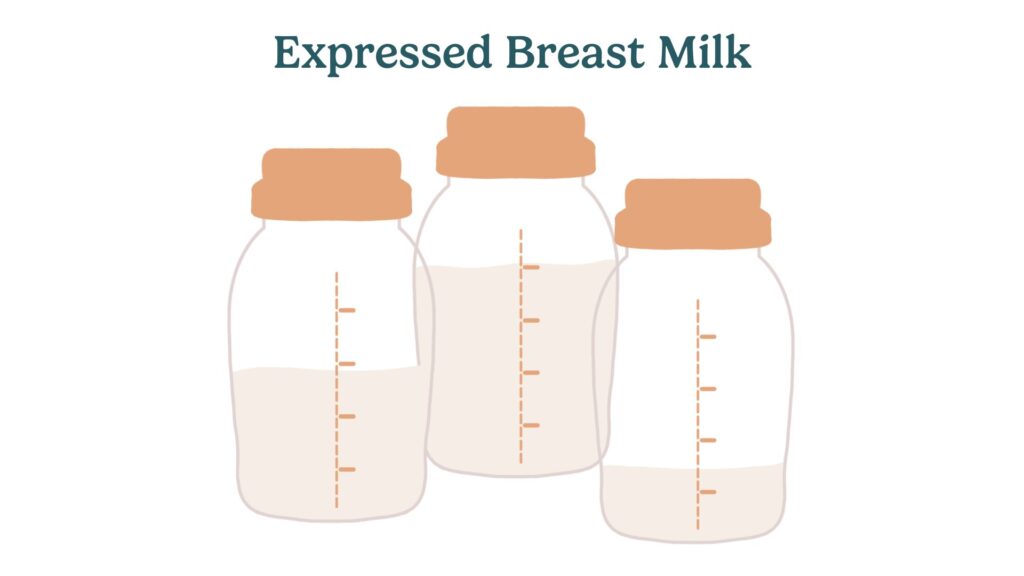expressed breastmilk

Expressed breastmilk
Expressed breastmilk is milk that is expressed from the breast and stored for later use. This allows someone else to feed your baby with a bottle or other feeding method, giving you more flexibility while making sure your baby still receives the benefits of breastmilk.
You can express milk manually or using a breast pump.
What to watch out for
When handling and storing expressed breastmilk, it's important to follow proper guidelines to make sure the milk remains safe and nutritious for your baby:
- Cleanliness: Always wash your hands and make sure all pump parts and storage containers are clean before expressing milk. This helps prevent contamination and keeps the milk safe for your baby.
- Storage guidelines:
- Freshly expressed milk can be stored at room temperature (77°F or cooler) for up to 4 hours.
- In the refrigerator (at 40°F or cooler) for up to 4 days.
- In the freezer (0°F or colder) for about 6 months, although it can be safe for up to 12 months. Read more about safe storage of breastmilk.
- Thawing frozen milk: Thaw frozen milk by placing it in the refrigerator overnight or using warm water. Avoid using a microwave to thaw or heat breastmilk, as this can create hot spots and destroy nutrients.
- Feeding expressed milk: Swirl or shake the milk to mix the fat that may have separated. If your baby doesn’t finish the bottle, discard any leftover milk after one to two hours.
- Lipase activity: Some mamas may find that their expressed milk develops a soapy or sour smell due to high lipase activity. Scalding the milk (heating it just until bubbles form around the edges) immediately after expressing and then quickly cooling it can help deactivate the lipase.
Physical limitations or health circumstances
Certain conditions or situations might affect expressing breastmilk:
- Breast surgery: Previous surgeries such as reductions or augmentations can impact milk ducts and affect milk expression. Work with a lactation consultant to find the best methods for expressing milk.
- Low milk supply: If you struggle with low milk supply, frequent and regular pumping can help stimulate production. Maintain proper hydration and nutrition, and consider consulting a lactation consultant for personalized advice. Read more about increasing milk supply.
- Premature babies: If your baby is premature and cannot nurse directly, expressing milk can be crucial for providing them with the necessary nutrients and antibodies. Hospital-grade pumps are often recommended in these cases.
Other terms
Understanding related terms can help you manage expressed breastmilk more effectively:
- Breast pump: A device used to extract milk from the breast. There are manual, electric, and hospital-grade pumps available.
- Milk storage bags: Specially designed bags for storing expressed breastmilk in the refrigerator or freezer. Recommended breastmilk storage bags.
- Let-down reflex: The reflex that releases milk from the alveoli into the ducts. Effective let-down is crucial for efficient milk expression. Read more about let-down
- Engorgement: Overfull breasts can be uncomfortable and may occur if you go too long without expressing milk. Regular pumping can help prevent engorgement. Read more about managing engorgement.
- Prolactin: The hormone responsible for milk production. Prolactin levels increase with frequent breastfeeding or pumping.
- Oxytocin: Known as the "love hormone," it causes the muscles around the alveoli to contract, pushing milk into the ducts and to your baby or pump. Read more about oxytocin
- Lipase: An enzyme that breaks down fats in the milk, which can sometimes cause expressed milk to taste or smell soapy. Scalding milk can reduce this issue.


